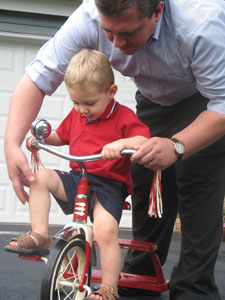 Most people think of “baby fat” as natural for infants and toddlers, but a new report from the Institute of Medicine says that childhood obesity is likely to continue into adulthood. Released yesterday, the report states that more than 20 percent of children between the ages of two and five are already overweight or obese. “What happens to a child during the first years of life is important to their current and future health,” the report states. “However, national efforts to prevent obesity have not paid enough attention to infants, toddlers, and preschool children.”
Most people think of “baby fat” as natural for infants and toddlers, but a new report from the Institute of Medicine says that childhood obesity is likely to continue into adulthood. Released yesterday, the report states that more than 20 percent of children between the ages of two and five are already overweight or obese. “What happens to a child during the first years of life is important to their current and future health,” the report states. “However, national efforts to prevent obesity have not paid enough attention to infants, toddlers, and preschool children.”
To combat the health consequences of early childhood obesity, the IOM also released a set of recommended prevention policies. The recommendations are mostly aimed at early childcare providers, educators and healthcare professionals, but the recommendations certainly apply to parents as well.
Play and Move
Reducing sedentary behavior by encouraging active play is a major focus of the obesity prevention recommendations. “To encourage a healthy weight, it’s better to get kids out moving more and focus on this side of the equation than try to heavily micromanage their food,” Joy Bauer, MS, RD, told DietsInReview.
 The report encourages daycares to provide children under the age of five with the opportunity to engage in physical activity for 15 minutes each hour, and to avoid punishing children by limiting their physical movements. The IOM reminds parents and childcare providers to use high chairs, car seats, strollers and cribs for their intended purposes, and not as a way to keep children in one place to monitor them easily. “Let them crawl around versus plopping them in the bouncy seats (we’re all guilty of doing that out of convenience),” said Bauer. “Whenever possible, encourage and allow toddlers and young kids to walk on their own instead of being carried or riding in the stroller.”
The report encourages daycares to provide children under the age of five with the opportunity to engage in physical activity for 15 minutes each hour, and to avoid punishing children by limiting their physical movements. The IOM reminds parents and childcare providers to use high chairs, car seats, strollers and cribs for their intended purposes, and not as a way to keep children in one place to monitor them easily. “Let them crawl around versus plopping them in the bouncy seats (we’re all guilty of doing that out of convenience),” said Bauer. “Whenever possible, encourage and allow toddlers and young kids to walk on their own instead of being carried or riding in the stroller.”
Bauer also recommends that parents buy toys that encourage physical movement, like tricycles, push-carts and baby gyms. She also suggests that parents explore community offerings. “Take advantage of public parks and playgrounds…they’re a good change of scenery and really can keep kids entertained for a long time.”
Watch Less
Limiting screen time is also an important means of reducing sedentary activity. Children between the ages of two and five should spend no more than two hours watching TV per day, using computers, or playing with other digital media, such as hand-held video games or cell phones. “Limiting screen time is critical, especially as kids grow up using more and more electronics at a younger age,” said Bauer. “Most daycares don’t follow recommendations on limiting TV and computer, which is very disappointing.”
Cutting down on television and internet use can also reduce a child’s exposure to food and beverage marketing at an age when they are particularly susceptible to these kinds of messages. The IOM urges government agencies to take an active role in creating marketing standards for food and beverage products intended for kids.
Sleep Sweetly
Another portion of the IOM report focuses on helping kids get plenty of high-quality sleep. The report states that “mounting epidemiologic evidence indicates that short duration of sleep is a risk factor for obesity among all age groups, including infants and children under the age of five.” Areas where children sleep at night or nap during the day should be quiet, dark and free of screen media.
Of course, proper nutrition is still a part of the equation, even for very young children. The IOM reiterates the importance of breastfeeding for the first six months of a child’s life. For older children, childcare providers need to offer nutrient-dense foods for both meals and snacks. Children should also be encouraged to pay attention to when they feel hungry or full, and should not be forced to eat when they do not feel hungry.
The concept of “kid-friendly” foods too often results in meals that consist of foods high in refined flour, fat and sugar, but low in fresh fruits, veggies and whole grains. Parents and teachers alike should encourage even the most picky eaters to try new foods. “Keep offering healthy choices!” advises Bauer. “Even if kids push away vegetables, fruits and other healthy foods, keep offering them. It can take many, many tries before a child learns to like a new food, so keep at it and try your best not to get frustrated or discouraged.” She adds that involving kids in preparing meals can also encourage healthy habits. “As foods become more familiar to them, kids are generally more willing to eat them.”
The report also says that adults should sit and eat the same food as the children, to create a good example. “Always model good eating habits,” adds Bauer. “Numerous studies show healthy habits are contagious…and kids are more likely to be interested in nutritious food (and physically active) when their parents are on board. So as a parent, the pressure is on.”
Also Read:

